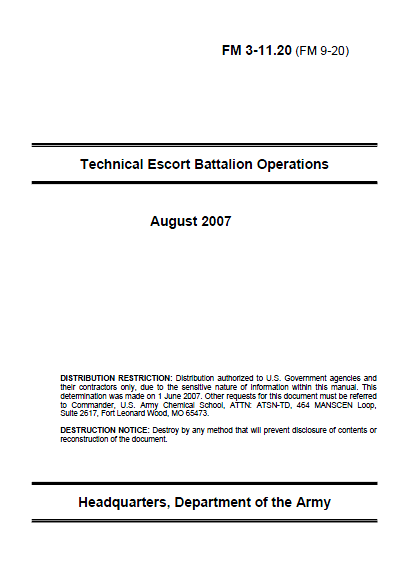The following manual was originally posted online on the file-sharing website 4shared.
FM 3-11.20 Technical Escort Battalion Operations
- 228 pages
- Distribution authorized to U.S. Government agencies and their contractors only, due to the sensitive nature of information within this manual
- August 2007
Field Manual (FM) 3-11.20 provides doctrine for planning and conducting technical escort (TE) operations. It describes—
• Mission analysis.
• Hazard and site characterization.
• Sampling.
• Monitoring.
• Mitigation.
• Decontamination.
• Disablement.
• Elimination.
• Munitions assessment.
• Emergency response.
• Sensitive-site exploitation (SSE).This manual specifically targets TE battalion commanders and staffs and key agencies with the tools and information necessary to plan and execute TE operations. It also provides reference information for chemical, biological, radiological, and nuclear (CBRN) personnel.
…
ORGANIZATION
1-3. TE battalions are organized into CBRN teams and remediation and restoration teams (RRTs).
• CBRN teams provide—
• Support to joint task forces (JTFs) and CCDRs.
• Forward employment in nonpermissive environments.
• Complete unit core capabilities to supported elements.
• Domestic crisis management support for chemical-biological (CB) devices to the Federal Bureau of Investigation (FBI), DOD, and local responders.
• CBRN advice, secure reach-back, CBRN assessment, and chemical expertise to other emergency response teams worldwide.
• RRTs are stewards of the environment. They provide—
• Remediation and response for CBRN material to the Army Corps of Engineers (COE), the product manager for nonstockpile chemical material, the Environmental Protection Agency (EPA), and state and local governments.
• Complete unit core capabilities to supported elements.…
DOMESTIC
2-4. The Department of Homeland Security (DHS) is the LFA for crisis and consequence management. DOD support to DHS includes (1) identifying, assessing, dismantling, transferring, and disposing of a contaminant and (2) conducting decontamination operations. Additionally, incidents involving CBRN environments often require a response according to a specific federal emergency operations plan, such as the National Response Plan (NRP), the National Oil and Hazardous Substances Pollution Contingency Plan (commonly referred to as the National Contingency Plan [NCP]; Title 40, Code of Federal Regulations [CFR] 300), or the Federal Radiological Emergency Response Plan (FRERP). These plans designate an LFA to coordinate the federal response, and the type of emergency determines the LFA. In general, an LFA establishes operational structures and procedures to assemble and work with agencies providing direct support. (Appendix A lists the LFA for each of the emergency support functions [ESFs] designated in the NRP.)
…
CIVIL SUPPORT
8-7. Civil support includes assistance to U.S. civic authorities for—
• Domestic emergencies.
• Designated law enforcement within the scope of restrictions required by 18 USC 1385 (the Posse Comitatus Act).
• Other incidents approved by the Secretary of Defense.8-8. Support must be consistent with military readiness, DOD directives, and the law. The employment of military forces within the United States and its territories and possessions under the auspices of civil support typically falls under the broad mission of military assistance to civil authorities. This mission consists of three mission subsets:
• Military support to civil authorities.
• Military support to civilian law enforcement agencies.
• Military assistance for civil disturbances.8-9. As directed in Homeland Security Presidential Directive (HSPD) 5, DHS is the LFA for CBRN crisis management and consequence management. DOD supports DHS by identifying, assessing, dismantling, transferring, and disposing of contaminants and by conducting decontamination operations. Additionally, an incident involving CBRN contamination is likely to require a response according to a specific federal emergency OPLAN (such as the NRP, NCP, or Federal Radiological Emergency Response Plan). These plans designate an LFA to coordinate the federal response depending on the type of emergency. In general, an LFA establishes operational structures and procedures to assemble and work with agencies providing direct support to the LFA.

